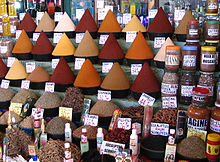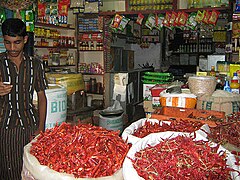スパイス
Spice/ja
スパイス(香辛料)とは、主に食品の香り付けや色付けに用いられる種子、果実、根、樹皮、またはその他の植物の物質である。スパイスはハーブとは区別され、植物の葉、花、茎を香り付けや付け合わせとして使用するものである。香辛料は薬、宗教儀式、コスメ、香水の製造に用いられることもある。例えば、バニラはフレグランス製造の原料としてよく使用されている。
スパイスは、新鮮なもの、丸ごと乾燥させたもの、あらかじめ挽いたものを乾燥させたものなど、いくつかの形態で提供されることがある。一般的に、スパイスは乾燥させたものである。スパイスは便利なように粉末にすることもある。乾燥したスパイスは保存期間が最も長いので、大量に購入して保存することができ、1食分あたりの単価が安くなる。生姜のようなフレッシュなスパイスは、乾燥したものよりも風味が良いが、フレッシュなスパイスは高価で、保存期間もかなり短くなる。また、ターメリックのように、生のままでは手に入らないスパイスもあり、挽いて購入しなければならないこともある。フェンネルやマスタードシードのような小さな種は、ホールとパウダーの両方で使用されることが多い。
スパイスの健康効果はよく言われることだが、その効果を証明する研究はまだ十分に行われていない。
インドは、世界のスパイス生産量の75%を占めている。歴史的には、インド亜大陸、東アジア、中東でスパイス貿易が発達し、料理にも反映されている。ヨーロッパではスパイスの需要があり、近世の探検を促す経済的・文化的要因のひとつとなった。
スパイスの語源は中英語で、古フランス語のespece, espis(c)e, espis(c)eに由来している。中英語辞典によると、古フランス語は英仏語のspeceに由来し、メリアム・ウェブスターによると、古フランス語は英仏語のespece、espisに由来する。両書とも、英仏語の語源がラテン語のspeciesであることに同意している。中英語のspiceは、13世紀に名詞として初めて使用されたことが知られている。
歴史
初期の歴史
スパイス貿易は、紀元前2000年頃までにインド亜大陸ではシナモンと黒胡椒、東アジアではハーブと胡椒で発展した。エジプトではミイラ作りにハーブが使われ、エキゾチックなスパイスやハーブの需要が世界貿易を活性化させた。紀元前1000年頃には、中国、韓国、インドでハーブを使った医薬品が発見された。初期の用途は、魔法、医療、宗教、伝統、保存に関連していた。
紀元前1700年頃には、メソポタミアでクローブが使用されていた。古代インドの叙事詩 Ramayanaには、クローブのことが書かれている。ローマ人は、長老プリニウスが書いたように、紀元前1世紀にはクローブを使用していた。スパイスに関する最古の文書記録は、古代エジプト、中国、インドの文化に由来する。 紀元前1550年のエジプト初期のエベルス・パピルスには、約800種類の薬効と数多くの薬用処置が記されている。東南アジアのバンダ諸島が原産地のナツメグは、紀元前6世紀にヨーロッパに伝わったと歴史家は考えている。
インドネシア商人は中国、インド、中東、アフリカ東海岸を旅した。アラブ商人は中東とインドを通るルートを促進した。その結果、エジプトの港湾都市アレクサンドリアがスパイス交易の中心地となった。ヨーロッパの香辛料貿易に先立つ最も重要な発見は、モンスーン風だった(紀元40年)。東方のスパイス栽培農家から西ヨーロッパの消費者に向けた航海は、かつて中東アラブのキャラバンによって促進された陸続きのスパイス・ルートに次第に取って代わった。
スパイスは旧約聖書にも登場するほど、古代世界では重要なものだった。創世記では、ヨセフは兄弟たちによって香辛料商に奴隷として売られた。出エジプト記では、マナは見た目がコリアンダーに似ていると描写されている。ソロモン雅歌では、男性の語り手が愛する人を多くのサフラン、シナモン、その他のスパイスに例えている。
中世

スパイスは中世のヨーロッパで最も需要が高く、高価な製品のひとつであり、最も一般的なものはブラックペッパー、シナモン(および安価な代替品カシア)、クミン、ナツメグ、ジンジャー、クローブであった。中世医学の主な理論が四体液説であったことを考えると、スパイスやハーブは食物の「体液」のバランスをとるために不可欠なものであり、パンデミックが頻発していた当時、健康を維持するための日々の基本であった。中世の医学を利用する人々によって望まれていたことに加え、中世のヨーロッパのエリートたちもスパイスを切望し、スパイスは「楽園」のものであり、「楽園」につながるものだと信じていた。ヨーロッパ貴族のスパイスに対する需要の一例として、12世紀にスペインにスパイスを持ち帰るために多大な資源を投入したアラゴン王が挙げられる。彼は特にワインに入れる香辛料を探しており、当時のヨーロッパの君主の中で香辛料を欲していたのは彼だけではなかった。
スパイスはすべてアジアやアフリカの農園から輸入されたもので、高価なものだった。8世紀から15世紀まで、ヴェネツィア共和国は中東とのスパイス貿易を独占し、その地位を利用して近隣のイタリア海洋共和国や都市国家を支配した。この貿易はこの地域を豊かにした。中世後期には、毎年約1,000トンの胡椒と1,000トンのその他の一般的な香辛料が西ヨーロッパに輸入されていたと推定されている。これらの商品の価値は、150万人分の穀物の年間供給量に相当した。最も高級だったのはサフランで、その鮮やかな黄赤色と風味のために使われた。 中世後期の北フランス料理で胡椒の代わりに使われたカルダモンの親戚であるグレイン・オブ・パラダイス、ロングペッパー、メース、スパイケナード、ガランガル、クベブなど、今ではヨーロッパ料理ではあまり使われなくなったスパイスもある。
Early modern period
Spain and Portugal were interested in seeking new routes to trade in spices and other valuable products from Asia. The control of trade routes and the spice-producing regions were the main reasons that Portuguese navigator Vasco da Gama sailed to India in 1499. When da Gama discovered the pepper market in India, he was able to secure peppers for a much cheaper price than the ones demanded by Venice. At around the same time, Christopher Columbus returned from the New World. He described to investors new spices available there.
Another source of competition in the spice trade during the 15th and 16th century was the Ragusans from the maritime republic of Dubrovnik in southern Croatia. The military prowess of Afonso de Albuquerque (1453–1515) allowed the Portuguese to take control of the sea routes to India. In 1506, he took the island of Socotra in the mouth of the Red Sea and, in 1507, Ormuz in the Persian Gulf. Since becoming the viceroy of the Indies, he took Goa in India in 1510, and Malacca on the Malay peninsula in 1511. The Portuguese could now trade directly with Siam, China, and the Maluku Islands.
With the discovery of the New World came new spices, including allspice, chili peppers, vanilla, and chocolate. This development kept the spice trade, with America as a latecomer with its new seasonings, profitable well into the 19th century.
Function

Spices are primarily used as food flavoring or to create variety. They are also used to perfume cosmetics and incense. At various periods, many spices have been believed to have medicinal value. Finally, since they are expensive, rare, and exotic commodities, their conspicuous consumption has often been a symbol of wealth and social class.
Preservative claim
It is often claimed that spices were used either as food preservatives or to mask the taste of spoiled meat, especially in the European Middle Ages. This is false. In fact, spices are rather ineffective as preservatives as compared to salting, smoking, pickling, or drying, and are ineffective in covering the taste of spoiled meat. Moreover, spices have always been comparatively expensive: in 15th century Oxford, a whole pig cost about the same as a pound of the cheapest spice, pepper. There is also no evidence of such use from contemporary cookbooks: "Old cookbooks make it clear that spices weren't used as a preservative. They typically suggest adding spices toward the end of the cooking process, where they could have no preservative effect whatsoever." Indeed, Cristoforo di Messisbugo suggested in the 16th century that pepper may speed up spoilage.
Though some spices have antimicrobial properties in vitro, pepper—by far the most common spice—is relatively ineffective, and in any case, salt, which is far cheaper, is also far more effective.
Classification and types

Culinary herbs and spices
Botanical basis
- Seeds, such as fennel, mustard, nutmeg, and black pepper
- Fruits, such as Cayenne pepper and Chimayo pepper
- Arils, such as mace (part of nutmeg plant fruit)
- Barks, such as True Cinnamon and cassia
- Flower buds, such as cloves
- Stigmas, such as saffron
- Roots and rhizomes, such as turmeric, ginger and galangal
- Resins, such as asafoetida
Common spice mixtures
- Advieh (Iran)
- Baharat (Arab world, and the Middle East in general)
- Berbere (Ethiopia, Eritrea and Somalia)
- Bumbu (Indonesia)
- Cajun (United States)
- Chaat masala (Indian subcontinent)
- Chili powder and crushed red pepper (Cayenne, Chipotle, Jalapeño, New Mexico, Tabasco, and other cultivars)
- Curry powder
- Five-spice powder (China)
- Garam masala (Indian subcontinent)
- Harissa (North Africa)
- Hawaij (Yemen)
- Jerk spice (Jamaica)
- Khmeli suneli (Georgia, former U.S.S.R.)
- Masala (a generic name for any mix used in the Indian subcontinent)
- Mixed spice (United Kingdom)
- Panch phoron (Indian subcontinent)
- Pumpkin pie spice (United States)
- Quatre épices (France)
- Ras el hanout (North Africa)
- Sharena sol (literally "colorful salt", Bulgaria)
- Shichimi tōgarashi (Japan)
- Speculaas (Belgium and Netherlands)
- Thuna Paha (Sri Lanka)
- Vegeta (Croatia)
- Za'atar (Middle East)

For ground spices, to grind a whole spice, the classic tool is mortar and pestle. Less labor-intensive tools are more common now: a microplane or fine grater can be used to grind small amounts; a coffee grinder is useful for larger amounts. A frequently used spice such as black pepper may merit storage in its own hand grinder or mill.
The flavor of a spice is derived in part from compounds (volatile oils) that oxidize or evaporate when exposed to air. Grinding a spice greatly increases its surface area and so increases the rates of oxidation and evaporation. Thus, the flavor is maximized by storing a spice whole and grinding when needed. The shelf life of a whole dry spice is roughly two years; of a ground spice roughly six months. The "flavor life" of a ground spice can be much shorter. Ground spices are better stored away from light.
Some flavor elements in spices are soluble in water; many are soluble in oil or fat. As a general rule, the flavors from a spice take time to infuse into the food so spices are added early in preparation. This contrasts to herbs which are usually added late in preparation.
Salmonella contamination
A study by the Food and Drug Administration of shipments of spices to the United States during fiscal years 2007–2009 showed about 7% of the shipments were contaminated by Salmonella bacteria, some of it antibiotic-resistant. As most spices are cooked before being served salmonella contamination often has no effect, but some spices, particularly pepper, are often eaten raw and present at table for convenient use. Shipments from Mexico and India, a major producer, were the most frequently contaminated. Food irradiation is said to minimise this risk.
Health research
Spices have been claimed to have health effects during both ancient and current times; for example, in 2017, the Washington Post said spices put "a natural pharmacy in your kitchen". The supposed health benefits include antioxidant and anti-inflammatory effects, and benefits towards certain diseases. A 2019 systematic review looked at studies of 25 spices and concluded that there is not enough evidence yet to support these supposed benefits, and that "further work is needed". The review noted that many studies were conducted by administering capsule or "artificial" forms of the spices, but spices are not normally consumed in this manner, and are normally consumed along other foods. Spices may reduce the need for salt as a flavoring agent in dishes, which has cardiovascular benefits.
Production

| Rank | Country | 2010 | 2011 |
|---|---|---|---|
| 1 | India | 1,474,900 | 1,525,000 |
| 2 | Bangladesh | 128,517 | 139,775 |
| 3 | Turkey | 107,000 | 113,783 |
| 4 | China | 90,000 | 95,890 |
| 5 | Pakistan | 53,647 | 53,620 |
| 6 | Iran | 18,028 | 21,307 |
| 7 | Nepal | 20,360 | 20,905 |
| 8 | Colombia | 16,998 | 19,378 |
| 9 | Ethiopia | 27,122 | 17,905 |
| 10 | Sri Lanka | 8,293 | 8,438 |
| — | World | 1,995,523 | 2,063,472 |
| Source: UN Food & Agriculture Organization|FAO|UN Food & Agriculture Organization | |||
Standardization
The International Organization for Standardization addresses spices and condiments, along with related food additives, as part of the International Classification for Standards 67.220 series.
Research
The Indian Institute of Spices Research in Kozhikode, Kerala, is devoted exclusively to conducting research for ten spice crops: black pepper, cardamom, cinnamon, clove, garcinia, ginger, nutmeg, paprika, turmeric, and vanilla.
Gallery
-
The Gato Negro café and spice shop (Buenos Aires, Argentina)
-
A spice shop selling a variety of spices in Iran
-
Night spice shop in Casablanca, Morocco
-
A spice shop in Taliparamba, India
-
Spices sold in Taliparamba, India
-
Spice seller, Kashgar market
-
Marrakesh]], Morocco
See also
- List of Indian spices – Variety of spices grown across the Indian subcontinent
- List of culinary herbs and spices
- Outline of herbs and spices
- Seasoning
- Spice mix
- Spice use in Antiquity
Further reading
Books
- Czarra, Fred (2009). Spices: A Global History. Reaktion Books. p. 128. ISBN 978-1-86189-426-7.
- Dalby, Andrew (2000). Dangerous Tastes: The Story of Spices. University of California Press. ISBN 978-0-520-23674-5.
- Freedman, Paul (2008). Out of the East: Spices and the Medieval Imagination. Yale University Press. ISBN 978-0-300-21131-3.
- Keay, John (2006). The Spice Route: A History. John Murray. ISBN 978-0-7195-6199-3.
- Krondl, Michael (2008). The Taste of Conquest: The Rise and Fall of the Three Great Cities of Spice. Random House. ISBN 978-0-345-50982-6.
- Miller, James Innes (1969). The spice trade of the Roman Empire, 29 B.C. to A.D. 641. Oxford: Clarendon P. ISBN 978-0-19-814264-5.
- Morton, Timothy (2006). The Poetics of Spice: Romantic Consumerism and the Exotic. Cambridge University Press. ISBN 978-0-521-02666-6.
- Seidemann, Johannes (2005). World Spice Plants: Economic Usage, Botany, Taxonomy. Springer. ISBN 978-3-540-22279-8.
- Turner, Jack (2004). Spice: The History of a Temptation. Knopf. ISBN 978-0-375-40721-5.
| この記事は、クリエイティブ・コモンズ・表示・継承ライセンス3.0のもとで公表されたウィキペディアの項目Spice/ja(10 December 2022, at 15:10編集記事参照)を素材として二次利用しています。 Lua error in Module:Itemnumber at line 91: attempt to concatenate local 'qid' (a nil value). |










![Marrakesh]], Morocco](https://upload.wikimedia.org/wikipedia/commons/thumb/3/34/Spice_Market%2C_Marakech_%282242330035%29.jpg/240px-Spice_Market%2C_Marakech_%282242330035%29.jpg)